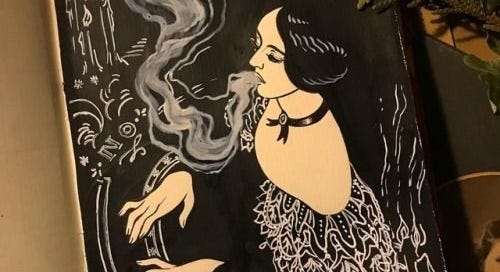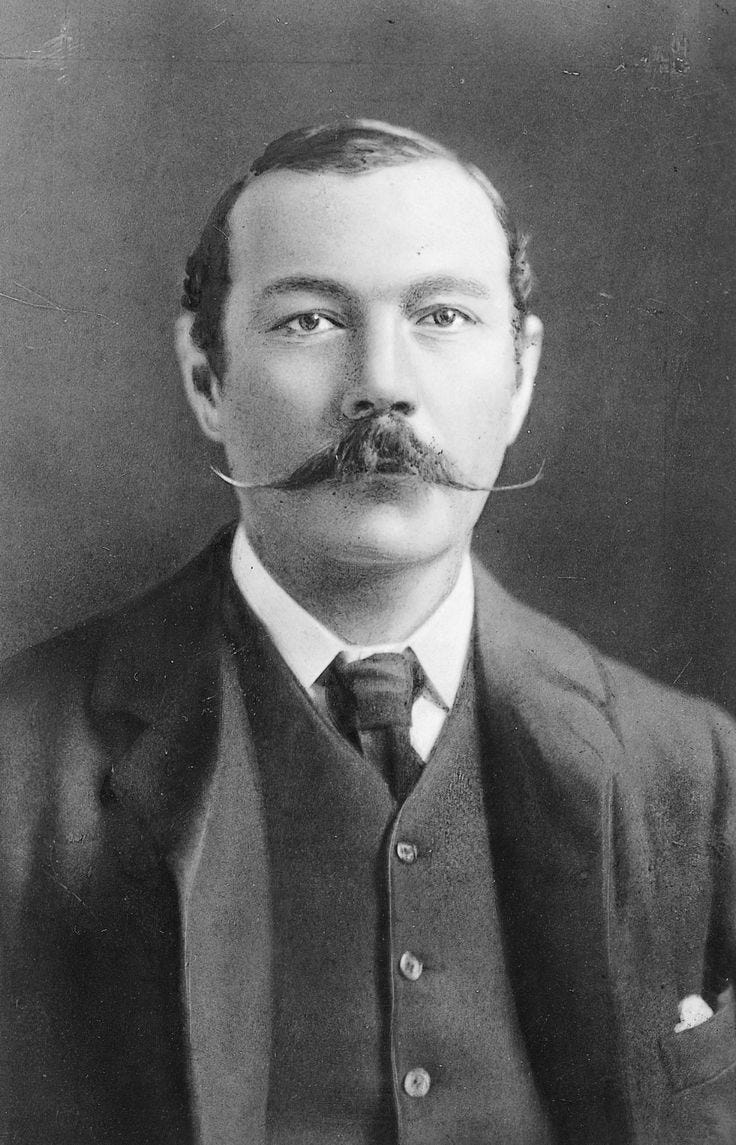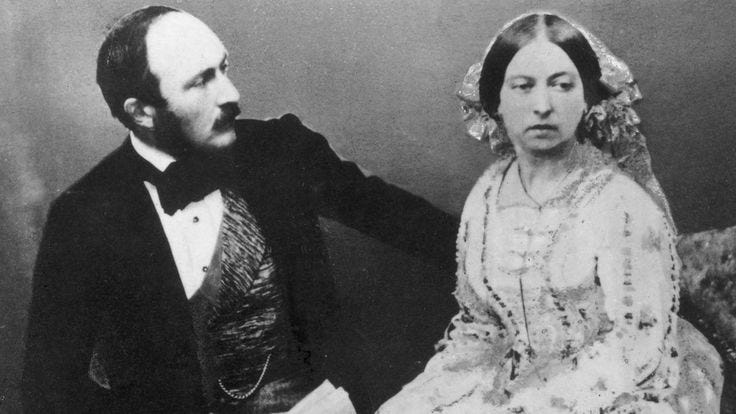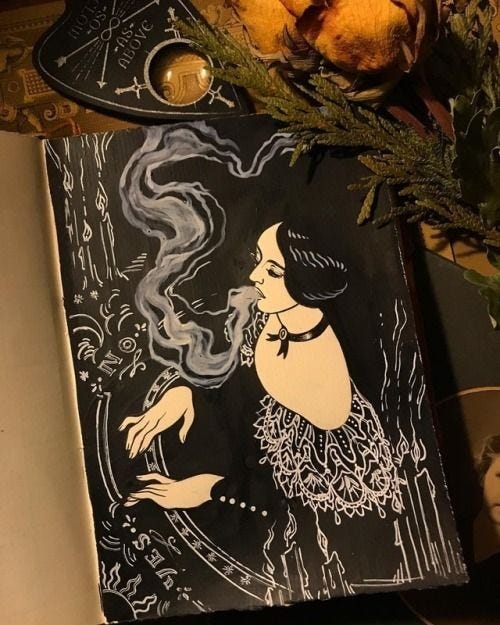Victorian spiritualism
Victorian were really keen on paranormal, and really into the other side and dead. You might say, they were fascinated by death.
Introduction
"What I can't accepty about spiritualism is the idea of millions of dead people (there must be standing room only on the Other Side) kept hanging about just waiting to be sent for by some old girl with a Ouija board in a Brighton boarding house, or a couple of table-tappers in Tring, for the sake of some inane conversation about the Blueness of the Infinite. I mean at least when you're dead you'll surely be spared such tedious social occasions." — John Mortimer's barrister in "Rumpole and the Dear Departed" (1981)
Spiritualism, the belief that the dead communicate with the living, became a fad throughout America and Europe during the 1850s. Spiritualism, which owes its beginnings to Emmanuel Swedenborg's writings on the spirit world, received additional stimulus from Anton Mesmer's experiments in what he called "animal magnetism" (hypnotism) that he believed involved the influence of celestial bodies upon terrestrial. Many Victorians, particularly those who had begun to abandon conventional religion, fervently believed in spiritualism, Elizabeth Barrett Browning among them (much to the dismay of her husband).
Although the Victorian era is often associated with scientific and technological progress, many Victorians were prone to the paranormal, supernatural and occult, of which the most popular forms in the late Victorian period included mesmerism, clairvoyance, electro-biology, crystal-gazing, thought-reading, and above all, Spiritualism. Sir Arthur Conan Doyle, like many late Victorians, was fascinated by the possibility of communication with the departed souls.
It is generally agreed that the modern Spiritualist movement began on April 1, 1848, in the village of Hydesville, New York, when two teenaged sisters, Margaret and Kate Fox, claimed that they had communicated with the ghost of a man murdered at the house years before their family moved in. Reports of this event first appeared in the New York Tribune and subsequently in other newspapers in America and Europe. The core belief of Spiritualism was that the living could communicate with the dead through the help of a medium endowed with a supernatural gift during mysterious and entertaining séance phenomena. Within the late Victorian counterculture of Spiritualism, a number of women and men gained renown and authority as skilled mediums.
Modern Spiritualism, a 'strange and fascinating American import', emerged in Britain in 1852, when the American Maria B. Hayden (1826-1883) visited London and offered her services as a medium. (Byrne 20) She conducted séances of table rappings and spirit messages for a guinea per head (five guineas for ten). (Wiley 12) In short time similar séances were offered by a host of local mediums.
Fascination with Spiritualism and psychic phenomena reached a high point in Great Britain in the late nineteenth century. A rich diversity of people during that period shared the fascination, formed organizations to pursue the subject systematically, and patronized a spiritualist press that served to publicize the activities of spiritualist circles around the country. [Oppenheim 28]
In the late Victorian era, a great number of people admitted to have communication with ghosts. Victorian Spiritualism, also known as the Spiritualism movement, emerged in the late nineteenth century and attracted people from different social classes, including Queen Victoria.
It should be noted that Victorian Spiritualism was particularly attractive to women because they were regarded as more spiritual than men. A female medium was often considered a better communicator than a male medium because she had allegedly a better predisposition to spiritual perfectability. Interestingly, spiritualists were concerned with the Woman Question and called for the recognition of women's rights.
And it is no accident that Spiritualism, a movement which privileged women and took them seriously, attracted so many female believers during a period of gender disjunction and disparity between aspiration and reality. Spiritualist culture held possibilities for attention, opportunity, and status denied elsewhere. In certain circumstances, it could also provide a means of circumventing rigid nineteenth-century class and gender norms. More importantly, it did so without mounting a direct attack on the status quo. Spiritualism had the potential, not always consciously realised, for subversion. [Owen 4]
Queen Victoria and Prince Albert participated in Spiritualist séances as early as 1846. On July 15 that year, the clairvoyant Georgiana Eagle demonstrated her powers before the Queen at Osborne House, on the Isle of Wight.
In 1861, the year when Prince Albert died of typhoid, a thirteen-year-old boy living in Leicester, Robert James Lees, who took part in a family séance, passed a message from Albert to the Queen in which he called her by the pet name known only to her and her late husband. Lees was invited to give séances at Windsor Castle during which Albert was called. After her death Queen Victoria was reported to send messages to her last surviving daughter, Princess Louise, through the medium Lesley Flint. [Buckland 340]
In the 1860s, Spiritualism became part of Victorian subculture with its mediums, specialist newspapers, pamphlets, treatises, societies, private and public séances which included table rapping, table tipping, automatic writing, levitation, and other communications with spirits.
In 1863, James Burns established the Progressive Library and Spiritualist Institution in Southampton Row in Holborn, London. The Spiritualist press in the late Victorian era included the British Spiritualist Telegraph, the Spiritualist, Human Nature, Medium and Daybreak, Two Worlds, and Light. Together with the emergence of the Spiritualist press, a number of Spiritualist societies were established in Great Britain, such as The Spiritualist Association of Great Britain (1872), The British National Association of Spiritualists (1873), The National Spiritualists' Federation (1890), and The Spiritualists' National Union (1901). London had the greatest number of Spiritualist societies: Charing Cross Spirit-Power Circle (1857), Christian Spiritual Enquirers in Clerkenwell, the East London Association of Spiritualists, the Marylebone Spiritualist Association, and others. (Owen 25)
One of the most famous Victorian mediums was Florence Cook (1856-1904), who materialised during her séances Katie King, the spirit-world daughter of a spirit called John King, who was in life a seventeenth-century buccaneer. Florence Cook was effective at table turning, automatic writing and levitation. Once when she was in a trance, she was levitated above the heads of the sitters and her clothes fell off down on the floor, which provided additional thrill to the audience. As Katie King, she also flirted with her sitters, touched and kissed them. (Tromp 2006, 32) She was invited to many respectable Victorian drawing rooms. Her séances were reported in detail in Spiritualists journals.
The Victorians were haunted by the supernatural. They delighted in ghost stories and fairy tales, and in legends of strange gods, demons and spirits; in pantomimes and extravaganzas full of supernatural machinery; in gothic yarns of reanimated corpses and vampires. Even avowedly realist novels were full of dreams, premonitions and second sight. It was not simply a matter of stories and storytelling, though, for the material world they inhabited often seemed somehow supernatural. Disembodied voices over the telephone, the superhuman speed of the railway, near instantaneous communication through telegraph wires: the collapsing of time and distance by modern technologies that were transforming daily life was often felt to be uncanny. [Bown et al. 1]
A number of eminent Victorians believed in the possibility of communication with the world of spirits. Robert Owen (1771-1858), an industrialist and social reformer, became a devout spiritualist in 1853 after having witnessed a series of séances with the American medium Maria Hayden. In 1871, another medium Emma Hardinge Britten (1823-1899) claimed that she had received The 'Seven Principles of Spiritualism' from the departed Robert Owen. They were adopted as guidelines by the British National Association of Spiritualists, established in 1873. Edward Bulwer-Lytton (1803-1873), a prolific writer, had a lifelong interest in the occult and Spiritualism. His novels, Godolphin (1833), Zanoni (1842), The Haunted and the Haunters (1859), A Strange Story (1862), and The Coming Race (1871) contain references to occult and supernatural phenomena.
Some Victorians, like Florence Marryat (1833-1899), the author of There Is No Death (1891), The Clairvoyance of Bessie Williams (1893), and The Spirit World (1894), saw Spiritualism as a religion, whereas others, like Arthur Conan Doyle, considered it a science. As Helen Sword writes, William Makepeace Thackeray, Elizabeth Barrett Browning and Robert Browning, Christina Rossetti, John Ruskin, Lewis Carroll, Laurence Oliphant, Rider Haggard, Rudyard Kipling, Andrew Lang, all participated in spiritualist practices at one time or another (5)
Elizabeth Barrett Browning, who was attracted to Swedenborg's idea of the resurrection of the spiritual body, was a keen participant in Spiritualist séances. Sir William Crookes, (1832-1919), one of the most important scientists of the late 19th century, the discoverer of thallium (1861) and the inventor of the radiometer (1875), was convinced about the reality of spiritual phenomena. Likewise, Sir Oliver Lodge (1851-1940), a physicist involved in the development of wireless telegraphy, studied psychical phenomena (telepathy) in the late 1880s, and was a member of the famous Ghost Club. In his most controversial book, Raymond or Life and Death (1916), dedicated to his son, who was killed in World War One, Lodge claimed to have heard from mediums that afterlife is not much different from this life. Another outstanding Victorian intellectual, Alfred Russel Wallace (1823-1913), a co-discoverer of the theory of evolution, described his experiences of the spirit world in his book, Miracles and Modern Spiritualism (1896).
Notable opponents of Spiritualist practices included Charles Dickens, who disdained spirit mediumship, but published many articles on the subject in the Household Words. Robert Browning attended Spiritualist séances with his wife Elizabeth Barrett Browning, but was skeptical about the supernatural phenomena. George Eliot dismissed Spiritualism as “the most painful form of the lowest charlatanerie.” (153) Alfred Tennyson said: “I am convinced that God and the ghosts of men would choose something other than mere table-legs through which to speak to the heart of man.” (Cottom 24) Likewise, Anthony Trollope wrote: “But when tables rap, and boards write, and dead young women come and tickle my knee under a big table, I find the manifestations to be unworthy of the previous grand ceremony of death.” (Cottom 25)
Michael Faraday (1791-1867), a physicist and chemist, who discovered electromagnetic induction, believed that Spiritualism was a hokum. In a letter to the Times in 1853, Faraday argued that table-tilting could be effected rather by involuntary muscle movement rather than unseen spirits. However, as Georgina Byrne observes, “After Faraday had died, his 'spirit' returned to a séance to admit that he was wrong in life and that claims of spiritualism were valid.” (37) Thomas Henry Huxley (1825-1895), the famous biologist, wrote: “The only good that I can see in the demonstration of the truth of 'Spiritualism' is to furnish an additional argument against suicide. Better to live a crossing-sweeper than to die and be made to talk twaddle by a 'medium' hired at a guinea a seance.” (Sword 4)
Ghost-Written Literature
It should be noted that several books were published as automatic transcripts of messages allegedly dictated by the ghosts of deceased authors. After his death Charles Dickens, of all Victorian authors, was the most frequent target of medium communications in séance rooms. As is known, Dickens did not finish his last novel, The Mystery of Edwin Drood. In 1873, Thomas James, an American printer, completed it, claiming that Dickens's spirit had dictated it to him.
William Thomas Stead (1849-1912), a noted journalist and social reformer, announced that he had received spirit communications from the departed Julia Ames, an American temperance reformer and journalist, which he published in the book After Death or Letters from Julia (1892). In 1926, Mrs. Hester Travers Smith (1868-1949), the daughter of a distinguished Shakespearian scholar, Professor Edward Dowden, and the wife of the prominent Dublin physician, claimed that she had received a message from the spirit of Oscar Wilde and published in the book, Psychic Messages from Oscar Wilde.







